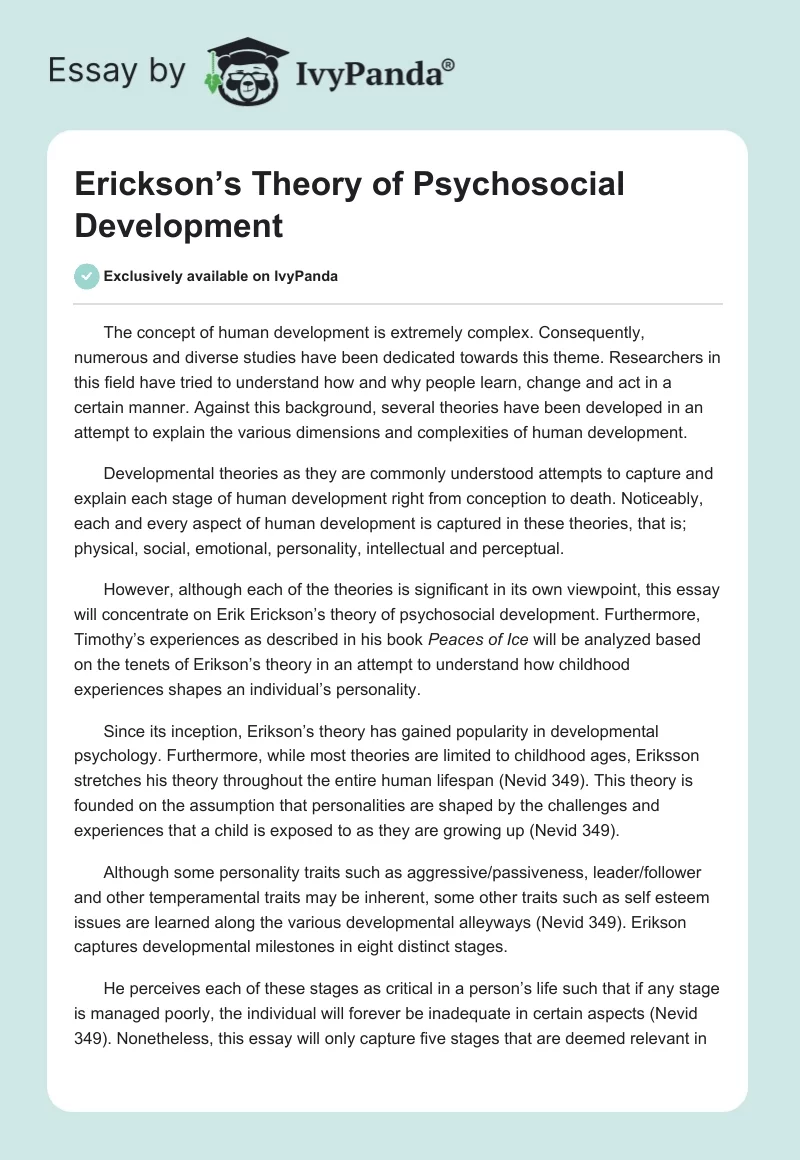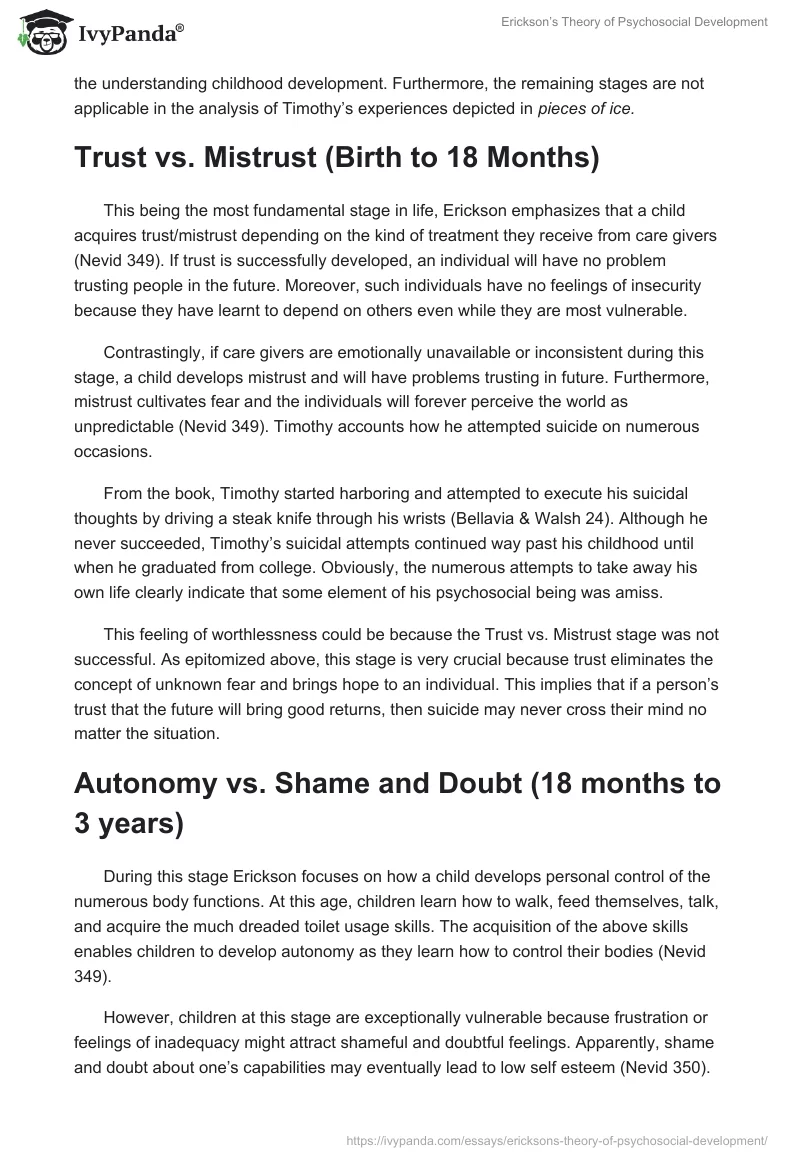The concept of human development is extremely complex. Consequently, numerous and diverse studies have been dedicated towards this theme. Researchers in this field have tried to understand how and why people learn, change and act in a certain manner. Against this background, several theories have been developed in an attempt to explain the various dimensions and complexities of human development.
Developmental theories as they are commonly understood attempts to capture and explain each stage of human development right from conception to death. Noticeably, each and every aspect of human development is captured in these theories, that is; physical, social, emotional, personality, intellectual and perceptual.
However, although each of the theories is significant in its own viewpoint, this essay will concentrate on Erik Erickson’s theory of psychosocial development. Furthermore, Timothy’s experiences as described in his book Peaces of Ice will be analyzed based on the tenets of Erikson’s theory in an attempt to understand how childhood experiences shapes an individual’s personality.
Since its inception, Erikson’s theory has gained popularity in developmental psychology. Furthermore, while most theories are limited to childhood ages, Eriksson stretches his theory throughout the entire human lifespan (Nevid 349). This theory is founded on the assumption that personalities are shaped by the challenges and experiences that a child is exposed to as they are growing up (Nevid 349).
Although some personality traits such as aggressive/passiveness, leader/follower and other temperamental traits may be inherent, some other traits such as self esteem issues are learned along the various developmental alleyways (Nevid 349). Erikson captures developmental milestones in eight distinct stages.
He perceives each of these stages as critical in a person’s life such that if any stage is managed poorly, the individual will forever be inadequate in certain aspects (Nevid 349). Nonetheless, this essay will only capture five stages that are deemed relevant in the understanding childhood development. Furthermore, the remaining stages are not applicable in the analysis of Timothy’s experiences depicted in pieces of ice.
Trust vs. Mistrust (Birth to 18 Months)
This being the most fundamental stage in life, Erickson emphasizes that a child acquires trust/mistrust depending on the kind of treatment they receive from care givers (Nevid 349). If trust is successfully developed, an individual will have no problem trusting people in the future. Moreover, such individuals have no feelings of insecurity because they have learnt to depend on others even while they are most vulnerable.
Contrastingly, if care givers are emotionally unavailable or inconsistent during this stage, a child develops mistrust and will have problems trusting in future. Furthermore, mistrust cultivates fear and the individuals will forever perceive the world as unpredictable (Nevid 349). Timothy accounts how he attempted suicide on numerous occasions.
From the book, Timothy started harboring and attempted to execute his suicidal thoughts by driving a steak knife through his wrists (Bellavia & Walsh 24). Although he never succeeded, Timothy’s suicidal attempts continued way past his childhood until when he graduated from college. Obviously, the numerous attempts to take away his own life clearly indicate that some element of his psychosocial being was amiss.
This feeling of worthlessness could be because the Trust vs. Mistrust stage was not successful. As epitomized above, this stage is very crucial because trust eliminates the concept of unknown fear and brings hope to an individual. This implies that if a person’s trust that the future will bring good returns, then suicide may never cross their mind no matter the situation.
Autonomy vs. Shame and Doubt (18 months to 3 years)
During this stage Erickson focuses on how a child develops personal control of the numerous body functions. At this age, children learn how to walk, feed themselves, talk, and acquire the much dreaded toilet usage skills. The acquisition of the above skills enables children to develop autonomy as they learn how to control their bodies (Nevid 349).
However, children at this stage are exceptionally vulnerable because frustration or feelings of inadequacy might attract shameful and doubtful feelings. Apparently, shame and doubt about one’s capabilities may eventually lead to low self esteem (Nevid 350). Similarly, Timothy’s shortcomings as an adult might be because he developed shame and doubt instead of autonomy as stipulated in Erikson’s second stage of development.
In peaces of ice, Timothy accounts how he was always being picked up by bullies in school (Bellavia & Walsh 34). The reason he could not fight back could be because he was always feeling insure and lacked confidence to retaliate.
As epitomized above, unsuccessful achievement during this stage attract a sense of inadequacy couple with low self esteem. In fact, Timothy recalls that he tried unsuccessful to conform to other kids in their neighborhood, but every time something was amiss either with his ‘outfit’, ‘missing teeth’ and so on (Bellavia & Walsh 46).
Initiative vs. Guilt (3 to 5 years)
Also known as play age, children begin to display some leadership skills by exercising control during play with their preschool peers. At this stage, children construct play situations and make up stories based on their surrounding environment (Nevid 349).
Consequently, initiative may or may not be successfully developed during this play stage. Apparently, if initiative fails to develop a sense of guilt and self-doubt settles in, and the individual never develop the capability to lead others in future (Nevid 349).
Industry vs. Inferiority (6 to 12 Years)
At this stage children are capable of intensive social interactions through which they explore their capabilities in various tasks. Erikson observed that children learnt to believe in their abilities following positive encouragement and praise from parents and teachers (Nevid 350).
Through constant reinforcement, children are able to successfully acquire a new set of skills and knowledge and that feeling of competence will eventually generate a sense of industry. However, constant criticism from parent and peers will attract doubtful feelings in one’s ability.
Such individuals will develop inferiority complex leading to instances of low self esteem throughout their life (Nevid 352). From the book, it is evident that Timothy suffers from low self esteem. His numerous attempts commit suicide coupled with his weird outfits could be as a result of low self esteem, and that his actions were a strategy to gain some recognition.
Identity vs. Role Confusion (12 to 18 years)
During this stage, individuals are trying to establish their identity as their seek pathways towards independence. Similar to the previous stage, the outcomes in this stage depends on the kind of input that an individual receives from peers, parents and other concerned parties (Nevid 35).
This implies that, positive encouragement and reinforcement will enable an individual to develop an positive identity coupled with a feeling of independent control of their own life. On the other hand, negative input will bring confusion because the individuals are unsure of their beliefs and desires in life (Nevid 351).
Concurrently, a closer analysis of Timothy experiences indicates that something must have gone wrong during this crucial stage. As explained on the book, Timothy preferred to interact with dolls and other items that are considered more feminine than masculine.
Timothy explains that the reason why preferred feminine over masculine items was not because he wanted to be a girl, but because he thought behaving like a girl would make him appear righteous and good (Bellavia & Walsh 46). The above analysis portrays Timothy as a confused individual owing to unsuccessful development during this developmental stage.
In a nutshell, it is clearly evident that our personality is determined by the kind of social interactions along the various developmental milestones. Similarly, the book pieces of ice, is a clear depiction of what could go wrong when a child fails to successful acquire the stipulated skills within each developmental stage.
Works Cited
Bellavia, Timothy, D. & Kristin, Walsh. Pieces of Ice. New York, NY: T.I.M.M-E. Company, Inc, 2009. Print.
Nevid, Jeffrey, S. Psychology: Concepts and Applications. Boston: Cengage Learning, 2008. Print.


